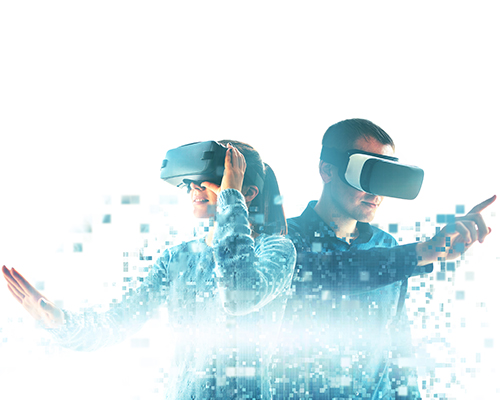All too often, VR is used more as a gimmick with “wow” effect, and not as an actual medium for learning in the context of vocational education. However, the use of VR can create a lot of added value for employees and companies. In his lecture at LEARNTEC 2020 on the joint research project VASE “Virtual and Analytics Service in Machinery and Plant Engineering”, Gerd Duffke from TRUMPF GmbH & Co. KG presented the results of a research project in which VR, in connection with machine learning, is being used to support autonomous learning.
 eLearning Journal: Hello Mr Duffke. Could you first briefly introduce yourself and your function at the TRUMPF GmbH & Co. KG?
eLearning Journal: Hello Mr Duffke. Could you first briefly introduce yourself and your function at the TRUMPF GmbH & Co. KG?
Gerd Duffke: I am a Project Leader at TRUMPF GmbH + Co. KG’s Corporate HR Learning & Development and, in this function, am responsible for special projects on demographic change as well as life phase oriented advanced training concepts. Beyond that, I act as a scout for mega trends such as Industrie 4.0.
For years, I was the director of technical product training for customer service personnel as well as chairman of the general and group works council and associate chairman of TRUMPF. I am looking back on 47 years of company service for the TRUMPF GmbH + Co. KG. I have been supervising the project VASE – Virtual Analytics in Service as the principal Project Director from TRUMPF since 2017.
eLearning Journal: In your lecture at LEARNTEC 2020 you presented the joint research project VASE (“Virtual and Analytics Service in Machinery and Plant Engineering”). Can you first describe the research project? What were the research objectives?
Gerd Duffke: The use of virtual learning and working environments as well as the logging of machine data and its evaluation in terms of service analytics allow for the optimization of existing service processes and contribute to the development of new training concepts. Both technologies have the potential to foster cooperative value creation processes from customers and service providers. The use of new technologies such as Virtual Reality (VR) contributes to the flexibilization, individualization, and optimization of value creation and, at the same time, mitigates existing situations of burden and demand for service technicians.
Aside from the challenge of an offensive utilization, it is about the technological acceptance and probability of reception through providers and customers as well as a successful integration. The learning environment evolved from VASE involves a functional 3D real-time capable virtual-interactive model of the TruPrint3000, a universal medium format press for the manufacturing of complex metallic components through 3D printing. The learning environment allows for a free or rather a guided interaction with the machine to learn and practice the operation, maintenance or repair through customers or service personnel. Here, scenarios can be created in single or multi user mode as well as via different user interfaces such as a head mounted display for immersive scenarios or, at the desktop, through the scenario editor.
eLearning Journal: Virtual learning and working environments that can complement or replace classical face-to-face events play a central role at VASE. What advantages or additional value does Virtual Reality offer? Can the virtual learning and working environments really replace the face-to-face training with its physical, real conditions in an adequate way?
Gerd Duffke: In VASE, we safeguard the process of the value chain, from condition monitoring at the machine up to the automated provision of custom-fit learning sequences at the digital machine twin or a virtual-collaborative learning offer at the virtual training center. Less or shortened face-to-face seminars mean great cost saving as well as a lower environmental impact. Also, VR exponentially increases the amount of practice at the seminars. In total, more participants can be trained and the level of knowledge can be increased, adjusted or even tested in a better way in addition to being available on demand. Additionally, neither material wear arises nor the damage of expensive devices is risked. SMUs are particularly benefiting from the VASE innovation since they can specifically and cost-effectively educate their employees with an equal standard.
eLearning Journal: Aside from VR, VASE also uses machine learning, a subdivision of artificial intelligence, which is a second trend topic. What role does machine learning play in VASE?
Gerd Duffke: The special feature of project VASE is machine learning through artificial intelligence in connection with innovative training opportunities. Through the combination of service analytics with virtual services it is possible for the first time to offer training or support in a fully integrated and automated process as well as individually tending to arising mistakes directly at the digital machine twin. The use of virtual learning and working environments as well as machine data logging and evaluation in the context of service analytics allow for an optimization of existing service processes and contribute to the development of new training concepts. With the flexibility gained from connecting service analytics and VR it is possible to offer the trainings on demand, flexibly across the world in terms of space and time as well as through various devices (VR glasses, desktop PC). Thereby, completely new digitally based services are possible and additional business models are opening up. By considering a comparison of the necessary and available data the application of service analytics shall be facilitated for both large companies and SMUs and, at the same time, a tried and tested integration model for promoting the widespread reception of a virtual and analytics service in the industrial service area of machinery and plant engineering shall be realized.
eLearning Journal: VASE is supposed to promote self-directed learning as well as enhance the employees’ self-learning competence. What advantages does self-directed learning offer both the em-ployees and Trumpf as a company?
Gerd Duffke: Our lives today cannot be imagined without lifelong learning since the world that we live in chang-es way too quickly. Continuous learning is a chance for further developing one’s own personality and skills – privately as well as professionally.
How do we learn best? Our New Understanding of Learning at TRUMPF: 70:20:10.
70% we learn from experience, e.g. in our everyday lives, in new projects, in daily tasks, during change, and mostly whenever the necessity for learning arises. 20% we learn from others, e.g. in the exchange with friends, colleagues, through feedback, and teamwork. Only 10% are we learn-ing through classical learning methods, “study time”, e.g. in classes, trainings, workshops or through reading. Classical learning methods often convey essential basics which, however, don’t necessarily overlap with the timing of when the necessity for learning arises. The VASE approach specifically supports the 70/20/10 learning model and offers attractive and expedient creative possibilities. VASE also enhances self-directed learning and the employees’ self-learning compe-tence. Very flexibly in fact, either as a highly interactive simulation training for the individual em-ployee or collaboratively at the virtual 3D training center, together with a specialist from Trumpf.
Image: © franz12 – stock.adobe.com





